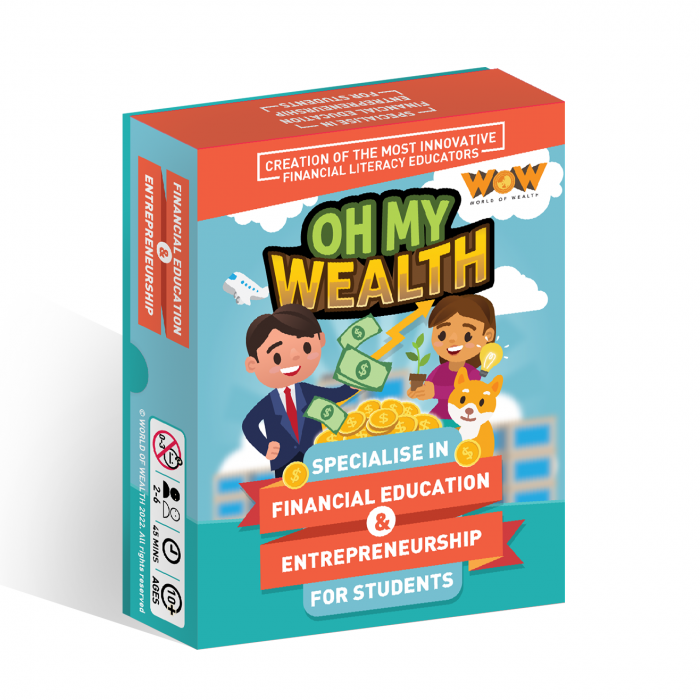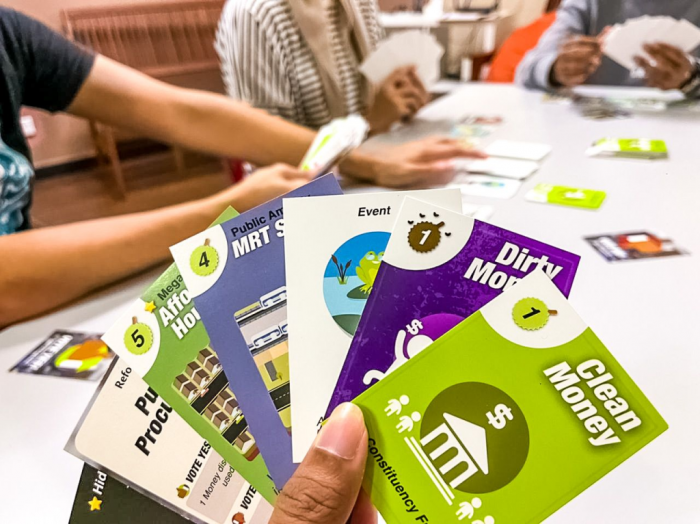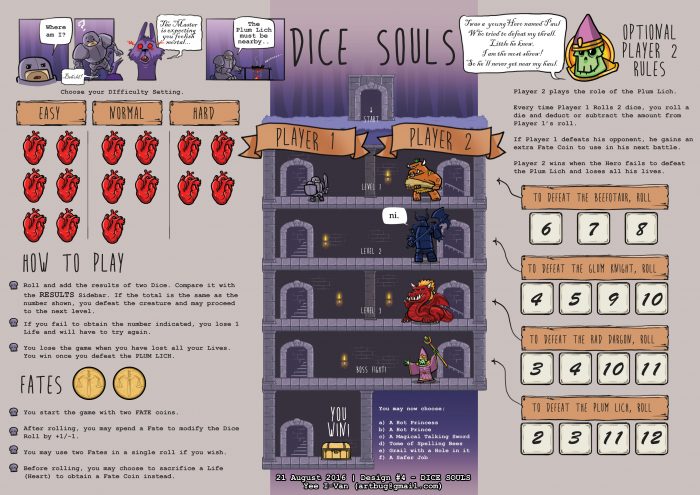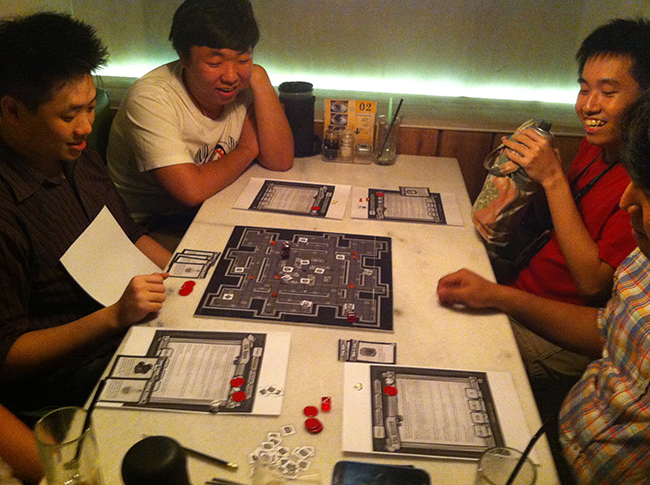Of Wealth Building

We just completed another client project and this time for a subject matter that is near and dear to our hearts. Financial Literacy for children is something that is usually underemphasized in our education system and our client hopes to do something about it with their new card game Oh My Wealth!

Of Anti-Corruption
Our latest commission was for a card-game that highlights utilizing ‘clean’ money to combat corruption. Hardly surprising as the client was an NGO that fights against Corruption ( C4 – The Center to Combat Corruption and Cronyism). It was a game where you play as a Member of Parliament and you have to build up your constituency while making policy changes that might affect your ethics. The game was designed by C4 and Alchymy Creative came in to visualize it in a bright and abstract Alegria style.



These are demo cards (hence the lack of rounded edges) but the actual product has since been in print and is sold online. It is RM30 on their online store and you can get it here.
More media: https://www.sinarharian.com.my/article/230469/khas/rasuah-busters/build-my-town-didik-tolak-rasuah-amal-tadbir-urus-baik
Roll 3
As a follow up to a long ago post about Dice probabilities, we derive 6n as a formula to use to calculate the possible outcomes.
Two dice 62 = 36 outcomes.
Three dice 63 = 216 outcomes.
If we take 3 Dice, the results would range from 3 – 18, or between (n – 6n).
The tricky part comes from trying to calculate the chances of each result without doing the mathematically inept person I am did, which was to list out all the possibilities.
- 3 = 1 + 1 + 1
- 4 = 1 + 1 + 2
- 5 = 1 + 1 + 3 = 2 + 2 + 1
- 6 = 1 + 1 + 4 = 1 + 2 + 3 = 2 + 2 + 2
- 7 = 1 + 1 + 5 = 2 + 2 + 3 = 3 + 3 + 1 = 1 + 2 + 4
- 8 = 1 + 1 + 6 = 2 + 3 + 3 = 4 + 3 + 1 = 1 + 2 + 5 = 2 + 2 + 4
- 9 = 6 + 2 + 1 = 4 + 3 + 2 = 3 + 3 + 3 = 2 + 2 + 5 = 1 + 3 + 5 = 1 + 4 + 4
- 10 = 6 + 3 + 1 = 6 + 2 + 2 = 5 + 3 + 2 = 4 + 4 + 2 = 4 + 3 + 3 = 1 + 4 + 5
- 11 = 6 + 4 + 1 = 1 + 5 + 5 = 5 + 4 + 2 = 3 + 3 + 5 = 4 + 3 + 4 = 6 + 3 + 2
- 12 = 6 + 5 + 1 = 4 + 3 + 5 = 4 + 4 + 4 = 5 + 2 + 5 = 6 + 4 + 2 = 6 + 3 + 3
- 13 = 6 + 6 + 1 = 5 + 4 + 4 = 3 + 4 + 6 = 6 + 5 + 2 = 5 + 5 + 3
- 14 = 6 + 6 + 2 = 5 + 5 + 4 = 4 + 4 + 6 = 6 + 5 + 3
- 15 = 6 + 6 + 3 = 6 + 5 + 4 = 5 + 5 + 5
- 16 = 6 + 6 + 4 = 5 + 5 + 6
- 17 = 6 + 6 + 5
- 18 = 6 + 6 + 6
So the grand result would be;
- Probability of a sum of 3: 1/216 = 0.5%
- Probability of a sum of 4: 3/216 = 1.4%
- Probability of a sum of 5: 6/216 = 2.8%
- Probability of a sum of 6: 10/216 = 4.6%
- Probability of a sum of 7: 15/216 = 7.0%
- Probability of a sum of 8: 21/216 = 9.7%
- Probability of a sum of 9: 25/216 = 11.6%
- Probability of a sum of 10: 27/216 = 12.5%
- Probability of a sum of 11: 27/216 = 12.5%
- Probability of a sum of 12: 25/216 = 11.6%
- Probability of a sum of 13: 21/216 = 9.7%
- Probability of a sum of 14: 15/216 = 7.0%
- Probability of a sum of 15: 10/216 = 4.6%
- Probability of a sum of 16: 6/216 = 2.8%
- Probability of a sum of 17: 3/216 = 1.4%
- Probability of a sum of 18: 1/216 = 0.5%
Dice Souls
Limitations can be seen to confine ones creativity but after years of work, I feel that it is actually the opposite. Limitations confine one which forces them to innovate even harder and focus more on their objectives. While limitless resources can be empowering, I’ve seen it create confusion or a sense of needing to do too much hence missing the primary objective altogether.
In a recent exercise on Coursera to create a single-player game on a single sheet of A4 with two dice, this was the outcome of such limited space. The emphasis was to make a game that could be played by a single person, provide incremental challenges using only two dice. Then the next step came refining the rules in order to be easily understood by people unfamiliar with the game. Then the exercise threw us a whopper by adding an additional player to the mix and then adding narrative to the game, all still within the limited space of an A4 piece of paper.
Here is my version of DICE SOULS, (as tough as Dark Souls but with Dice!). Feel free to print out and play with two dice.

On Dice-Rolls and Results
Dungeon Fodder had a loot table which operated on a dice-roll. One issue was that the odds for “Leveling Up!” were too ridiculously difficult so I had to think about why. A player only levels up on a roll of 3 or 18 but what were the odds? I had a look around and this site explained it pretty thoroughly to me;
3 dice or 3d6 equates to 6 to the power of 3 which comes up to 216 possibilities. Typically a 3d6 would yield you only 16 possibilities (3 to 18) so from there one can calculate the odds of getting a specific number. While not something astronomically new, it does highlight the fact that game designers must have a strong understanding of mathematics to handle data, probability and statistics. Therefore the odds for 3 dice would be as follows;
Probability of a sum of 3: 1/216 = 0.5%
Probability of a sum of 4: 3/216 = 1.4%
Probability of a sum of 5: 6/216 = 2.8%
Probability of a sum of 6: 10/216 = 4.6%
Probability of a sum of 7: 15/216 = 7.0%
Probability of a sum of 8: 21/216 = 9.7%
Probability of a sum of 9: 25/216 = 11.6%
Probability of a sum of 10: 27/216 = 12.5%
Probability of a sum of 11: 27/216 = 12.5%
Probability of a sum of 12: 25/216 = 11.6%
Probability of a sum of 13: 21/216 = 9.7%
Probability of a sum of 14: 15/216 = 7.0%
Probability of a sum of 15: 10/216 = 4.6%
Probability of a sum of 16: 6/216 = 2.8%
Probability of a sum of 17: 3/216 = 1.4%
Probability of a sum of 18: 1/216 = 0.5%
Also on an unrelated note, the designs for an Orientation type activity is underway and there are thoughts of using comparison tables such as the one below. It has been a long time since I’ve seen one used but it is a fun and visual way to figure out the results of a dice roll. I might also try to integrate this into Dungeon Fodder if the need arises and it helps by visually explaining concepts on the game.

Price Point
During the first Gameplay Test, testers were asked about how much they thought Dungeon Fodder could typically charge on an international market. Fortunately 3 of the playtesters were frequent board-gamers that also purchased plenty of physical tabletop games themselves so they mentioned they were typically used to paying up to 50USD for a product of similar content. A game mentioned was Ankama’s Krosmaster and Skylander that also has miniatures.
Miniatures would increase the cost of the production of the game but also add to the ‘collectible’ quality of the game. Perhaps some research into this is timely.
Gameplay Test #1
I conducted the first gameplay test after a long time at the nearby Hainan Kopitiam at SS2 Mall with some play-testers Nicholas Tan, Ken Chan, Lum Hong Leong, Eric Khoo and Aliff Marzuki.This is the first of two planned Gameplay Tests do strengthen the mechanics of the game. Participants to the playtest were taught how to play and then allowed to play the game with minimal supervision. The 2nd Playtest session was meant to utilize the feedback from the first into a more refined version and test to see if the changes improved the game.
Two games were played at an average of an hour per game. The 2nd time around was much quicker once players were familiar with the mechanics of the game. The first game was between a mix of heroes with each player picking a hero of their liking. The 2nd game was between 6-players (myself included) and was a match between Rogues and Wizards.

Here is a list of things that were commented upon or suggestions given to develop the game further.
Players that die should probably be ressurrected as an Undead Zombie instead of just moving the Monster
This is to ensure that players have something to do AFTER they die. Perhaps players that died still earn 2 Gold for every kill they make while in undead form regardless of their team alignment.
Passing of players and Monster on the board
Players should not be able to bypass other players and the Monster on the board to ensure that the Monster functions as a block-in mechanic. Another possibility would be to give the Rogue the option to ‘Tumble’ to roll away from Monsters and other players.
Ranged Abilities for all players
Rogues should be given minor range abilities of perhaps 1 or 2 tiles to throw daggers instead of having to go melee with Warriors.
Leap / Charge
In addition to Ranged attacks, Warriors should be given the ability to Leap forward one or two squares but risk being stunned on a failed leap. Rolling beneath your Skill would mean a failure and the Warrior is moved forward but is stunned (unable to take an Action). A success would allow the warrior to move forward and make an attack.
Debuff Warrior Defence.
In game, Removed +1 to Warrior Defence and Removed Warrior’s ability to brew potions. Might reconsider returning one ability as Potions now have a risk factor In brewing and might result in being poisoned. (1 – Poisoned, 2-3 Nothing, 4-6 Succeed)
Monster Movement needs tweaking
1 – Fail, 2-5 Move 1 tile, 6-Move 2 tiles
Wizard blinks through walls.
If Wizards were limited in their teleportation abilities, it could be balanced by allowing them to blink through walls.
Wizard’s Fireball 10 spaces only
Currently the Wizards have a strong advantage over Rogues because of the long-range capabilities. Limiting their fireballs may help balance out the odds but it might also cripple the wizards.
Other Considerations
Regeneration, Moving through walls, Rogues can Evade (reroll Defence), Double Edge abilities that damage both attacker and victim.
Next Step
The next step would be to decide if these changes are worthwhile committing to and what chain-reactions would these implementation cost the gameplay. I have found that minor changes could have drastic effects to how a game works and this is referred to as the fine art of ‘Balancing’.
It Builds Character
I’ve finally settled on a look for the characters of Dungeon Fodder, namely the Warrior, Wizard and the Rogue. This has actually undergone many changes and I realize part of the problem could be my own perception that any art is never finished and every time you come back to an unfinished piece, there will be a part of you that wants to chuck the entire thing out and start over again.

Well I’ve settled for this look for the characters for a number of reasons;
Thinking back to my past as an animator, if you character has long lasting appeal, then there is a higher chance your game would make it commercially. I also feel these designs would have a higher ‘cute’ rating and would look interesting as potential plushies (how and when is a problem for another day). This was something I picked up while pitching for an animated series a few years back. Merchandising always has to have a place in your project planning. Many artists cringe at the thought of such crass commercial considerations infringing on the artistic process but that’s the way the industry works.
After much thought, I do think there is some truth in that, the problem is where to draw the line.
Borders Stocks European Board-Games
I recently found out that Borders stocks European Board-games. This is an interesting potential and I’d add it to my list of things to check out.

Research Progress Report #1
Research Progress Report #1
While initially planning to research into ways of commercializing a board-game of my own devising, I’ve realized that I would need to first explore what has been done and from that, find out what works and what doesn’t. In order to achieve that I am now exploring the potential of Practice-based or practice-led research which based on a guide written by Linda Candy is an “original investigation undertaken in order to gain new knowledge partly by means of practice and the outcomes of that practice.”
I have yet to discuss this in full with my supervisor but I think my next step would be to interview the many table-top game developers in Malaysia and find out how they attempted to commercialize their own board-games and also whether or not those methods were successful or did not achieve their intended goals. Armed with that knowledge, I would like to plan out my own pathway to commercializing my own board-game entitled “Dungeon Fodder” and see if my new approach works.
The few hurdles I foresee would be the means to manufacture as well as sell my board-game. During my research I’ve also come across many websites and services that sell small-order custom board-games by independent developers internationally. This could also be a practical modal that I can emulate or subscribe to in order to self-publish my board-game and document its progress.
Looking forward, I’d be looking into these areas as I conduct my research (through Interviews) with various parties such as table-top developers, board-game communities, manufacturers, retailers and also businesses.
Research Areas
Inspiration – How and why develop board-games as opposed to other mediums
Prototyping & Testing – Their process of prototyping and testing and documenting the results
Funding Projects – How did they fund their projects?
Manufacturing – How did they approach manufacturing?
Self-Publishing vs Publishing – Their opinions on the benefits and cons of both methods.
Copyright, Patents & Protection – How did they go about protecting their Intellectual Property.
Social Media & Marketing – How did they market their products.
Board-game Festivals – Alternate ways of bringing board-games to the international arena.

